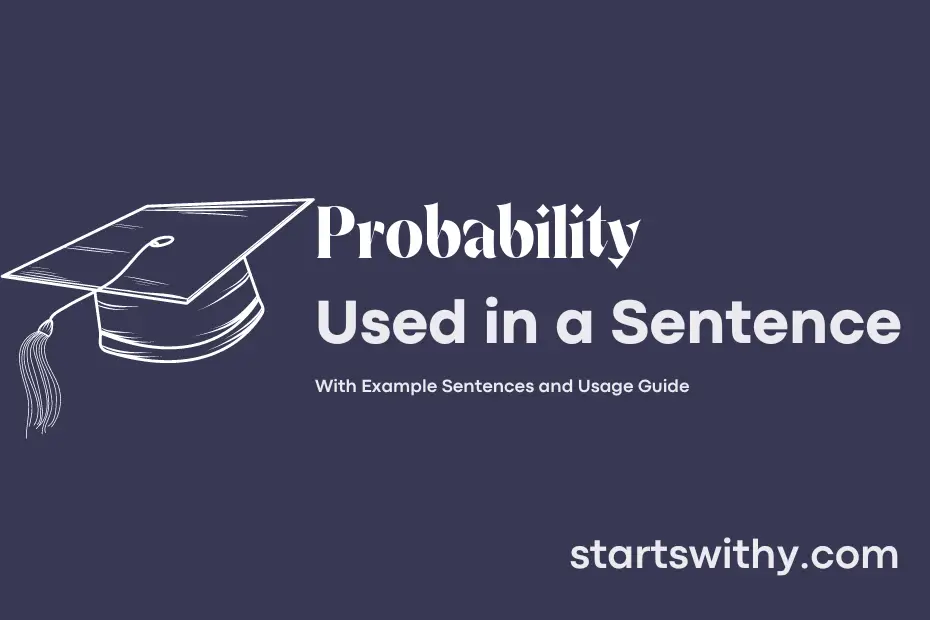Have you ever wondered about the likelihood of a certain event happening? Well, that’s where probability comes into play. Probability is a mathematical concept that measures the likelihood of an event occurring, usually expressed as a fraction or percentage. It helps us understand the uncertainty and randomness in various situations, making it a crucial tool in fields such as statistics, gambling, and science.
7 Examples Of Probability Used In a Sentence For Kids
- There is a probability of rain tomorrow.
- The probability of winning is high if you practice.
- What is the probability of getting a red balloon?
- The probability of seeing a rainbow after rain is high.
- There is a low probability of finding a four-leaf clover.
- The probability of guessing the right answer is 50%.
- If you work hard, the probability of success increases.
14 Sentences with Probability Examples
- Probability plays a crucial role in predicting the chances of passing an exam based on past performance.
- Students often use probability to estimate the likelihood of certain questions appearing in the question paper.
- Understanding probability can help in making decisions related to which topics to focus on for better exam preparation.
- By learning about probability, students can be more strategic in choosing the right study material to improve their chances of success.
- Group study sessions can involve discussing the probability of different types of questions being asked in the upcoming test.
- Knowing the probability of certain events occurring can be beneficial in devising a study schedule that covers all important topics effectively.
- Classroom discussions may involve analyzing the probability of a particular concept being included in the final exam.
- By applying the concept of probability, students can prioritize their study time based on the likelihood of certain topics being tested.
- In group projects, students can use probability to distribute tasks based on individual strengths and interests.
- Online quizzes often have questions that require calculating the probability of certain outcomes, encouraging students to apply their knowledge in a practical way.
- Participating in extracurricular activities can help students develop a sense of probability by understanding the likelihood of winning in competitions or events.
- Organizing study groups with peers can provide opportunities for discussing and solving probability problems together.
- Attending guest lectures on statistics can offer valuable insights into the application of probability in various real-life scenarios.
- By working on case studies that involve analyzing probability in decision-making processes, students can enhance their critical thinking skills.
How To Use Probability in Sentences?
Probability is a measure of how likely an event is to occur. When probability is used in a sentence, it typically indicates the chance or likelihood of something happening.
Here are some examples of how to use probability in a sentence:
– “There is a high probability of rain tomorrow, so you may want to bring an umbrella.”
– “The probability of flipping a coin and it landing on heads is 50%.”
– “What is the probability of selecting a red marble from a bag containing 3 red marbles and 5 blue marbles?”
To calculate probability, you can use a formula based on the number of favorable outcomes divided by the total number of possible outcomes. For example, if you want to find the probability of rolling a 6 on a six-sided dice, you would have 1 favorable outcome (rolling a 6) out of 6 possible outcomes (numbers 1-6), giving you a probability of 1/6 or approximately 16.67%.
Understanding probability is important in various fields such as mathematics, statistics, and science. By grasping the concept of probability, you can make informed decisions, assess risks, and predict outcomes with more confidence.
Conclusion
In conclusion, sentences using the term “probability” describe the likelihood or chance of an event occurring. These sentences help convey the level of certainty or uncertainty associated with a particular outcome based on available information, data, or conditions. By incorporating the concept of probability into communication, individuals can express expectations, forecasts, or assessments with clarity and precision.
Whether discussing weather forecasts, gambling odds, or scientific predictions, sentences that include the term “probability” offer valuable insights into the likelihood of various outcomes. Understanding and using such sentences can enhance decision-making processes, aid in risk assessment, and facilitate effective communication in a wide range of contexts where uncertainty plays a role.



